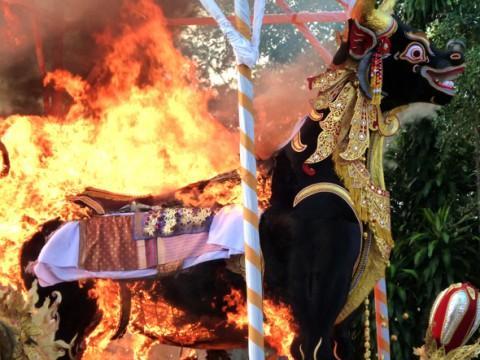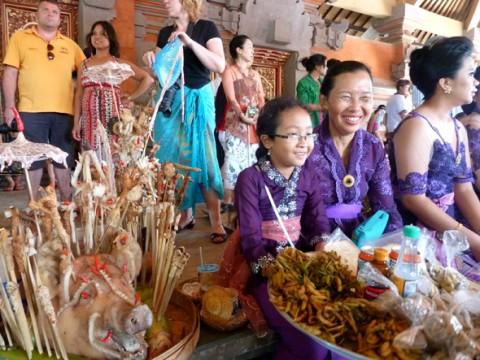By Lisa Niver Rajna
To kick off our year-long trek through Southeast Asia, my husband and I spent two months exploring the Indonesian[1] island of Bali[2] with no set itinerary. While in the town of Ubud[3], home of the Balinese royal family, we saw that the Puri Agung Ubud were building a bade (cremation tower) and an enormous twenty-foot papier–mâché bull for a cremation ceremony for Prince Tjokorda Putra Dharma Yudha, so we decided to attend.
Johnny, a dive master and member of the local band, T-WRECK, told us we were lucky (b-ungtung in Balinese) to see such a large ceremony — or to see one at all. The last royal cremation occurred two years ago. Many of the locals we befriended in the diving meccas of Amed[4] and Tulamben[5] explained that they could not afford to attend but would have loved to join us on the big day.
Wayan, the owner of the Puri Madha Beach Bungalows[6] in Tulamben, who had organized a cremation ceremony for a family member the year before, said that a ceremony on the lower end might cost 200 million Rupia ($20,000 USD) and estimated that the cost for the king’s cremation would be more than ten times that amount.
To our surprise, the ceremony was a happy event. In Hindu culture, the burning of the dead is a sacred ritual that frees the soul inside so that it can be reincarnated.
During the ceremony, the authorities turned off the electricity in the city so that when the hulking bade moved down Raya Ubud no one would get shocked if it happened to brush against the power wires. As it was explained to me by Wayan, the prince “was very well liked.”

The body is placed inside 20-foot papier-mache the bull before being cremated. (Photograph by Lisa Niver Rajna)
Greg Roach of Spirit Quest Tours[7] told me that much of modern day Balinese society has roots in the ancient Royal Court of Java, cremation rituals included. The ceremonies always utilize the same elements—the bull, the tower, and the burning.
“When someone dies, they are buried,” Roach explained. “Later, the body is disinterred, the bones are burned and the ashes are taken to Sanur to be scattered. After a period of purification, the spirit moves into the family temple.”
We gathered at the Ubud Palace while the crowds lined Raya Ubud, waiting and watching as the bull and tower were marched along the street and then moved to the other end of town where officiates were preparing for the cremation itself. When the coffin arrived, the body, shrouded in white, was removed and placed into the bull.
Officials honored royal ancestors, which are supposed to guide future generations, and living members of the royal family from their place in the temple.
We were moved to be able to attend the ceremony and grateful to the Balinese people for allowing us to participate in different aspects of their spiritual practices.
Check out the short video we took while we were there[8]: The closest thing to being there yourself.
Travel writer Lisa Niver Rajna[9] is spending the year in Southeast Asia with her husband (both of whom are members of the Traveler’s Century Club). Follow her adventures on their blog, wesaidgotravel.com[10], and on Twitter @wesaidgotravel[11].
References
- ^ National Geographic Travel – Indonesia Guide (travel.nationalgeographic.com)
- ^ Traveler – Bali Photo Gallery (traveler.nationalgeographic.com)
- ^ Indo site – Ubud (www.indo.com)
- ^ Bali Travel Life site – Amed (www.bali-travel-life.com)
- ^ Lonely Planet – Tulamben (www.lonelyplanet.com)
- ^ TripAdvisor – Puri Madha Beach Bungalows (www.tripadvisor.in)
- ^ Spirit Quest Tours site (www.spiritquesttours.com)
- ^ YouTube – Ubud Cremation Ceremony (www.youtube.com)
- ^ Lisa Niver Rajna’s Facebook page (www.facebook.com)
- ^ wesaidgotravel.com (wesaidgotravel.com)
- ^ Lisa Niver Rajna’s Twitter profile (twitter.com)
